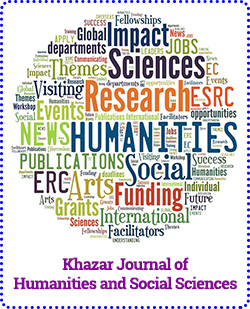New Media as Modern Communication Technologies: The Digital Dimension
DOI:
https://doi.org/10.5782/.kjhss.2023.79.91Keywords:
New media, social communications, advertising, media communications, digital technologies, journalismAbstract
The latest media nowadays is a set of interaction tools for expanding the subjects’ communicative, sensory and cognitive capabilities involving information and communication technologies that correspond to the historical period of their development. Currently, these are technical means (PC equipment with a software complex, with various means of supporting network communications), information resources and communication platforms based on digital technologies. Modern media meet the needs of long-distance, international interactive communication and integrate a number of means for the individual’s creative implementation, his social activity and participation in society’s information processes. The purpose of the academic paper is a theoretical and practical description of the concept, individual types and features of using new media as technologies that provide communicative processes in the digital mode. Methodology. In the process of preparing the present research, several methods were applied. In particular, analytical and bibliographic methods, induction, deduction, analysis, and synthesis of information were used to study scientific literature on applying new media when working with communication processes in the digital dimension. System-structural, comparative, logical-linguistic methods, abstraction, and idealization were used to study and process data. The questionnaire survey was conducted by the research’s authors in online mode for the practical clarification of media tools’ certain aspects in the field of communications. Results. Based on the research results, the features of using new media types as modern communication technologies in the digital space were studied.
Downloads
References
- Bowman-Smith, C.K., Sosa-Hernandez, L. & Nilsen, E.S. (2021). The other side of the screen: the impact of perspective-taking on adolescents’ online communication. Journal of Adolescence, 92, 46–56.
https://linkinghub.elsevier.com/retrieve/pii/S0140197121001081. https://doi.org/10.1016/j.adolescence.2021.08.006. - Dienlin, T. & Johannes, N. (2020). The impact of digital technology use on adolescent well-being. Dialogues in Clinical Neuroscience, 22, 2, pp. 135-142,
https://www.scopus.com/record/display.uri?eid=2-s2.0-85088464920&origin=inward&txGid=1938be24bf52b245f583ee520b67b440. https://doi.org/10.31887/DCNS.2020.22.2/tdienlin. Dienlin and Johannes, 2020. - Girelli, L., Cavicchiolo, E., Lucidi, F., Cozzolino, M., Alivernini, F. & Manganelli, S. (2019). Psychometric properties and validity of a brief scale measuring basic psychological needs satisfaction in adolescents. Journal Educational, Cultural Psychological Studies, 20, 215–29. https://www.ledonline.it/index.php/ECPS-Journal/article/view/1831. doi: 10.7358/ecps-2019-020-gire
- Gomez-Baya, D., Rubio-Gonzalez, A. & de Matos, M.G. (2019). Online communication, peer relationships and school victimisation: a one-year longitudinal study during middle adolescence. International Journal of Adolescence and Youth, 24, 2, 199–211. https://www.tandfonline.com/doi/full/10.1080/02673843.2018.1509793. DOI: 10.1080/02673843.2018.1509793.
- Hoareau, N., Bagès, C. & Guerrien, A. (2021). Cyberbullying, self-control, information, and electronic communication technologies: do adolescents know how to exercise self-control on the Internet? International Journal of Bullying Prevention, 1–11. https://link.springer.com/article/10.1007/s42380-021-00099-2. https://doi.org/10.1007/s42380-021-00099-2.
- Humprecht, E., Castro Herrero, L., Blassnig, S. & Brüggemann, M. (2022). Media Systems in the Digital Age: An Empirical Comparison of 30 Countries. Journal of Communication, 72, 3. https://tinyurl.com/mr2fyf76 https://doi.org/10.1093/joc/jqab054.
- Johannes, N., Nguyen, T.V., Weinstein, N. & Przybylski, A.K. (2021). Objective, subjective, and accurate reporting of social media use: no evidence that daily social media use correlates with personality traits, motivational states, or well-being. Technology, Mind and Behavior, 2, 2. https://tmb.apaopen.org/pub/accuracy-in-reporting-social-media-use/release/2. https://doi.org/10.1037/tmb0000035.
- Kaaniche, N., Laurent, M. & Belguith, S. (2020). Privacy enhancing technologies for solving the privacy-personalization paradox: Taxonomy and survey. Journal of Network and Computer Applications, 171, 102807. https://www.sciencedirect.com/science/article/abs/pii/S1084804520302794. https://doi.org/10.1016/j.jnca.2020.102807.
- Meier, A. & Reinecke, L. (2020). Computer-mediated communication, social media, and mental health: a conceptual and empirical meta-review. Communication Research, 48, 1–28. https://journals.sagepub.com/doi/10.1177/0093650220958224. https://doi.org/10.1177/0093650220958224.
- Meier, A. & Schäfer, S. (2018). The positive side of social comparison on social network sites: how envy can drive inspiration on Instagram. Cyberpsychology, Behavior, and Social Networking, 21, 7, 411–7. https://www.liebertpub.com/doi/10.1089/cyber.2017.0708. https://doi.org/10.1089/cyber.2017.0708.
- Nick, E.A., Cole, D.A., Cho, S.J., Smith, D.K., Carter, T.G. & Zelkowitz, R.L. (2018). The online social support scale: measure development and validation. Psychological Assessment, 30, 9, 1127–43. https://psycnet.apa.org/doiLanding?doi=10.1037/pas0000558. https://doi.org/10.1037/pas0000558.
- Noon, E.J. & Meier, A. (2019). Inspired by friends: adolescents’ network homophily moderates the relationship between social comparison, envy, and inspiration on Instagram. Cyberpsychology, Behavior, and Social Networking, 22, 12, 787–93. https://www.liebertpub.com/doi/10.1089/cyber.2019.0412. https://doi.org/10.1089/cyber.2019.0412.
- Paddock, D.L. & Bell, B.T. (2021). It’s better saying I look fat instead of saying you look fat”: a qualitative study of UK adolescents’ understanding of appearance-related interactions on social media. Journal of Adolescent Research, 1–29. https://journals.sagepub.com/doi/10.1177/07435584211034875. https://doi.org/10.1177/07435584211034875.
- Przybylko, G., Morton, D.P., Morton, J.K., Renfrew, M.E. & Hinze, J. (2021). An interdisciplinary mental wellbeing intervention for increasing flourishing: two experimental studies. The Journal of Positive Psychology, 17, 573–88. https://www.tandfonline.com/doi/full/10.1080/17439760.2021.1897868. DOI: 10.1080/17439760.2021.1897868.
- Quach, S., Thaichon, P., Martin, K.D., Weaven S. & Palmatier R.W. (2022). Digital technologies: tensions in privacy and data. Journal of the Academy of Marketing Science, 50, 1299–1323 https://link.springer.com/article/10.1007/s11747-022-00845-y.
- Rosič, J., Janicke-Bowles, S.H., Carbone L., Lobe, B. & Vandenbosch, L. (2022). Positive digital communication among youth: The development and validation of the digital flourishing scale for adolescents. Frontiers in Digital Health, 4, 975557. https://www.frontiersin.org/articles/10.3389/fdgth.2022.975557/full. https://doi.org/10.3389/fdgth.2022.975557.
- Schreurs, L. &Vandenbosch, L. (2022). The development and validation of measurement instruments to address interactions with positive social media content. Media Psychology, 25, 2, 262–89. https://www.tandfonline.com/doi/abs/10.1080/15213269.2021.1925561?journalCode=hmep20. https://doi.org/10.1080/15213269.2021.1925561.
- Valkenburg, P., Beyens, I., Pouwels, J.L., van Driel, I.I. & Keijsers, L. (2021). Social media use and adolescents’ self-esteem: heading for a person-specific media effects paradigm. Journal of Communication, 71, 1, 56–78.
https://academic.oup.com/joc/article/71/1/56/6124731?login=false. https://doi.org/10.1093/joc/jqaa039. - Valkenburg, P.M., Meier, A. & Beyens, I. (2022). Social media use and its impact on adolescent mental health: an umbrella review of the evidence. Current Opinion in Psychology, 44, 58–68.
https://linkinghub.elsevier.com/retrieve/pii/S2352250X21001500.https://doi.org/10.1016/j.copsyc.2021.08.017. - Verbeij, T., Loes, J., Beyens, P.I. & Valkenburg, P.M. (2021). The accuracy and validity of self-reported social media use measures among adolescents. Computers in Human Behavior Reports, 3, 100090.
https://www.sciencedirect.com/science/article/pii/S2451958821000385. https://doi.org/10.1016/j.chbr.2021.100090.








